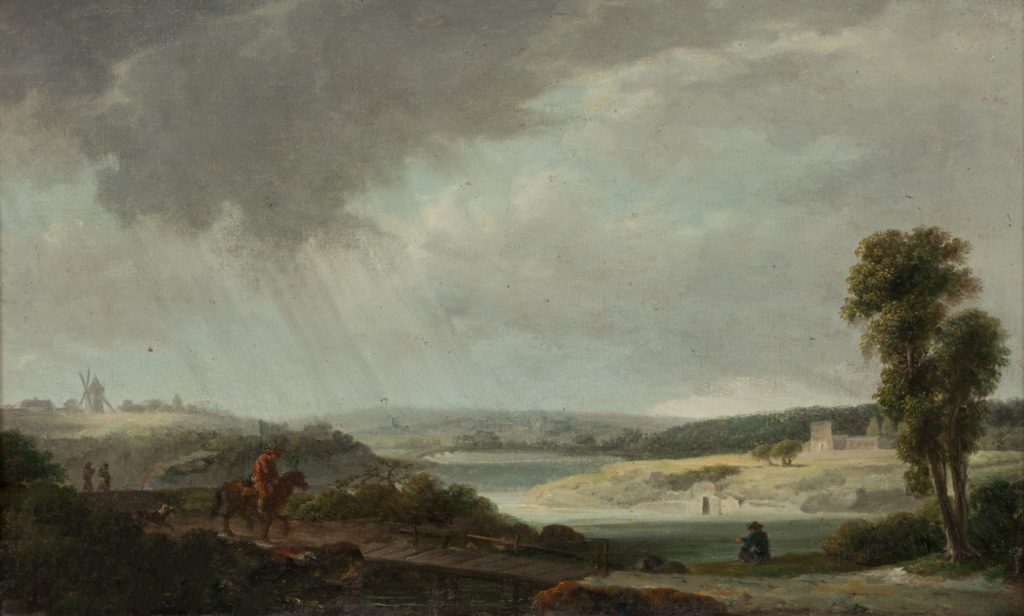Cavalier aux abords de la passerelle
Horseman approaching a bridge
Oil on paper, marouflage on canvas
Size
25 x 37.5 cm
Exhibition
Georges Bernard Michel is one of those painters who painted for his own enjoyment, rather than for fame or money. Almost unknown during his lifetime and largely forgotten after his death in 1842, Michel’s oeuvre has enjoyed a resurgence in the past few years. Michel was admired by Vincent van Gogh and holds importance as a precursor of the school of Barbizon. Today, his works can be found in museums around the world; among them the Louvre, the Musée d’Orsay, the Victoria and Albert Museum and the Metropolitan Museum.
The little we know about Michel’s personal life and career was gleaned from his second wife and widow by the art critic Alfred Sensier, who published the first biographie of the painter. Born in 1763, Michel came from humble origins. His father worked at the market of Les Halles in Paris. As a child, Michel was placed in the care of the Vertus village vicar. Thus he grew up on the plain of Saint Denis, “which he loved like Paradise”, and which would prove a lifelong inspiration. Sent to learn painting from the history painter Leduc, Michel would rather forego the atelier for walks in the countryside to draw. He soon went his own way, marrying at a very early age and teaching drawing to earn money in order to study with other painters. (Alfred Sensier, Étude sur Georges Michel, Paris, 1873)
Michel lived through turbulent times, and met key players of the Ancien Regime, the Revolution and the Napoleonic era alike. If his widow is to be believed, the Duc de Guiche journeyed with him to Germany to paint the Rhine landscape, while another patron took him to Switzerland. The Baron d’Ivry, an amateur painter himself, became his friend and patron, jealously buying up all his works and even showing them as his own. Allegedly, Michel was enamored with the painter Elisabeth Vigée-Lebrun, and copied seventeenth-century Dutch masters for her husband, the art dealer Lebrun. Denon, director of the Louvre under Napoléon, supposedly gave him a great deal of restoration work to do, as Michel excelled in it. He even got his own atelier at the museum. However, it is difficult to verify these stories.
In any case, Michel’s is a vast and coherent oeuvre of drawings and paintings. Michel famously never signed or dated paintings – only a few early works bear his signature. He supposedly said: “The painting has to please without the aid of a name or a label. The old painters never signed theirs: their signature is in their talent”. As Michel’s oeuvre is quite consistent in style, this makes it difficult to date his works and outline his career as a painter.
Generally, his work is divided into three phases. In the first phase, he collaborated with the artists Jean-Louis Demarne and Jacques-François Swebach, who often painted staffage in his landscapes. After about 1808, Michel’s style grew in finesse and he became more focused on the treatment of light, the sky and space. The paintings from this period show more unity in composition, with vast expanses of landscape and wide perspectives under stormy skies in the manner of Philips de Koninck. And finally, after 1830 Michel was at the peak of his career. His style became even more lyrical and visionary, his brushstrokes broader and his paint thicker. The dramatic tension in his paintings was underlined by the heaviness of the skies and the contrasts of light and dark. The landscapes presented here can be placed in this final phase.
It is evident that Michel placed himself in the tradition of seventeenth-century painters. We don’t know whether Michel travelled to Holland himself, but he certainly had the opportunity to study their works in the collections of his patrons, at the Louvre, or from prints. The influence of Jacob van Ruysdael, Rembrandt, Meindert Hobbema and Philips de Koninck is evident in his works. Michel is said to have remarked: “The Flemish and the Dutch […] they are the good painters, the braves, the most fearless, the most unaffected”.
The landscape Horseman approaching a bridge too owes much to the works of Philips de Koninck. Like De Koninck, Michel composes a wide, panorama landscape seen as it were from a high viewpoint such as a hill. The land is wide and even, intersected by a meandering river. The horseman and his dog, the fisherman and the two figures on the left are just accessories to the vast plain. A small mill can be seen, typical of Michel’s work at this time. The painter would go out daily to walk and sketch in his beloved Montmartre, which at this time was still full of mills. His landscapes earned him the nickname ‘Ruysdael of Montmartre’. As with De Koninck, however, Michel’s landscapes cannot be related to a specific place.
This is also true for the other painting, Boats at the seaside. Michel took home his sketches and, seated by the fireplace next to his wife, worked them into small paintings. The larger part of the painting is taken up by the sky, dramatically filled with clouds. A storm has just passed, and the sky opens up, so the sun becomes visible. This treatment echoes the work Coup de soleil (The Ray of light, Louvre) by Van Ruysdael, which was much admired in the nineteenth century, and was itself a response to Rembrandt’s Landscape with a Castle (now also in the Louvre). In Michel’s lifetime, the Ruysdael was owned by Louis XVI. The figures of the fishermen, dressed in seventeenth-century costumes, underline the reference.






